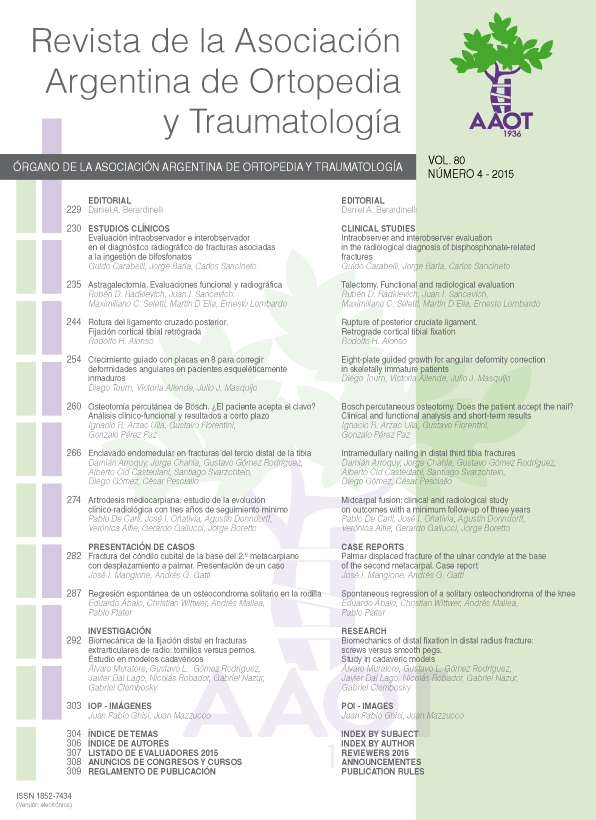Enclavado endomedular en fracturas del tercio distal de tibia. [Intramedullary nailing in distal tibial fracture.]
Contenido principal del artículo
Resumen
Descargas
Métricas
Detalles del artículo

Esta obra está bajo licencia internacional Creative Commons Reconocimiento-NoComercial-CompartirIgual 4.0.
La aceptación del manuscrito por parte de la revista implica la no presentación simultánea a otras revistas u órganos editoriales. La RAAOT se encuentra bajo la licencia Creative Commons 4.0. Atribución-NoComercial-CompartirIgual (http://creativecommons.org/licenses/by-nc-sa/4.0/deed.es). Se puede compartir, copiar, distribuir, alterar, transformar, generar una obra derivada, ejecutar y comunicar públicamente la obra, siempre que: a) se cite la autoría y la fuente original de su publicación (revista, editorial y URL de la obra); b) no se usen para fines comerciales; c) se mantengan los mismos términos de la licencia.
En caso de que el manuscrito sea aprobado para su próxima publicación, los autores conservan los derechos de autor y cederán a la revista los derechos de la publicación, edición, reproducción, distribución, exhibición y comunicación a nivel nacional e internacional en las diferentes bases de datos, repositorios y portales.
Se deja constancia que el referido artículo es inédito y que no está en espera de impresión en alguna otra publicación nacional o extranjera.
Por la presente, acepta/n las modificaciones que sean necesarias, sugeridas en la revisión por los pares (referato), para adaptar el trabajo al estilo y modalidad de publicación de la Revista.
Citas
2. Lee YS, Chen SW, Chen SH, Chen WC, Lau MJ, Hsu TL. Stabilisation of the fractured fibula plays an important role in the treatment of pilon fractures: a retrospective comparison of fibular fixation methods. Int Orthop 2008;33: 695-9.
3. Bucholz RW, Heckman JD, Court-Brown C (eds.) Rockwood & Green’s: Fractures in Adults, 6th ed. Philadelphia: Lippincot Williams & Wilkins; 2006.
4. Topliss CJ, Jackson M, Atkins RM. Anatomy of pilon fractures of the distal tibia. J Bone Joint Surg Br 2005;87:692-7.
5. Blachut PA, O’Brien PJ, Meek RN, Broekhuyse HM. Interlocking intramedullary nailing with and without reaming treatment of closed fractures of the tibial shaft. A prospective, randomized study. J Bone Joint Surg Am 1997;79:640-6.
6. Collinge C, Kuper M, Larson K, Protzman R. Minimally invasive plating of high-energy metaphysial distal tibia fractures. J Orthop Trauma 2007;21:355-61.
7. Nork SE, Shwartz AK, Agel J, Holt SK, Schrick JL, Winquist RA.
Intramedullary nailing of distal metaphyseal tibial fractures. J Bone Joint Surg Am 2005;87:1213-21.
8. Sarmiento A, Sharpe FE, Ebramzadeh E, Normand P, Shankwiler J. Factors influencing the outcome of closed tibial fractures treated with functional bracing. Clin Orthop Relat Res 1995;315:8-24.
9. Sheerin DV, Turen CH, Nascone JW. Reconstruction of distal tibia fractures using a posterolateral approach and a blade plate. J Orthop Trauma 2006;20:247-52.
10. Gustilo RB, Anderson JT. Prevention of infection in the treatment of one thousand and twenty-five open fractures of long bones: retrospective and prospective analyses. J Bone Joint Surg Am 1976;58:453-8.
11. Kitaoka HB, Alexander IJ, Adelaar RS, Nunly JA, Myerson MS, Sanders M. Clinical rating systems for the ankle, hind foot, mid foot, hallux and lesser toes. Foot Ankle Int 1994;15:349-53.
12. Court-Brown CM, MC Birnie J. The epidemiology of tibia fractures. J Bone Joint Surg Br 1995;77:417-21.
13. White RR, Babikian GM. Tibia shaft. En: Ruedi TP, Murphy WM (eds.) AO Principles of Fracture Management. Stuttgard: Thieme; 2000:519-36.
14. Yaligod V, Rudrappa GH, Nagendra S, Shivanna UM. Minimizing the complications of intramedullary nailing for distal third tibial shaft and metaphyseal fractures. J Orthop 2013;11(1):10-8.
15. Janssen KW, Biert J, Kampen A. Treatment of distal tibial fractures: plate versus nail. A retrospective outcome analysis of matched pairs of patients. Int Orthop 2007;31:709-14.
16. Ruedi T, Allgower M. Fractures of the lower end of the tibia into the ankle joint. Injury 1969;1:92-9.
17. Buzzi R, Bertini A, Cecchi F, Giron F. Distal tibial-fibular fractures: treatment with fibular fixation and locked intramedullary nailing. J Orthop 2009;1:33-40.
18. Kumar A, Charlebois SJ, Cain EL, Smith RA, Daniels AU, Crate JM. Effect of fibular plate fixation on rotational stability of simulated distal tibial fractures treated with intramedullary nailing. J Bone Joint Surg Am 2003;85:604-8.
19. Teitz CC, Carter DR, Frankel VH. Problems associated with tibial fractures with intact fibulae. J Bone Joint Surg Am 1980;62:770-6.
20. Rouhani A, Elmi A, Akbari Aghdam H, Panahi F, Dokht Ghafari Y. The role of fibular fixation in the treatment of tibia diaphysis distal third fractures. Orthop Traumatol Surg Res 2012; 98:868-72.
21. Whittle AP. Campbell’s Operative Orthopaedics, 11th ed., Philadelphia: Mosby; 2008; vol. 3, p. 3122.

